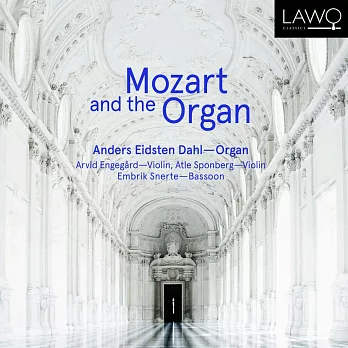莫札特曾經在寫給他父親的信上指出:在他的眼中與耳中,管風琴無疑是樂器中的女王.莫札特本身也喜歡演奏管風琴,不過為管風琴創作的作品卻不多.這張專輯由挪威管風琴大師Anders Eidsten Dahl領銜,在奧斯陸的教堂內錄下了莫札特少有的管風琴作品,非常值得一聽.
In spite of his enthusiasm for the instrument and the fact that Mozart himself liked to play the organ, he did not compose much music for "the queen of instruments". The organists of the day improvised when they played for mass, and the organ at that time was not a concert instrument in need of a wide-ranging repertoire.
Mozart's original music for organ consists of 17 one-movement "Epistle sonatas" -- chamber music written between 1772 and 1780 for masses in Salzburg. The instrumentation for 14 of these is two violins and basso continuo, while the remaining three are written for more instruments. The pieces are short -- this is music written to be played between the reading of texts. The organ is given an ever greater concertizing role from the first to the last, and the Sonata in C (K336) can be described as a small organ concerto.
In 1790 Mozart was commissioned to write music for what was known as a "Flotenuhr" -- a large grandfather clock containing a self-playing organ. The instrument was popular at the time -- there are also compositions for the instrument written by Handel, C.P.E. Bach and Haydn. Often the music was meant to describe an event or situation -- the music Mozart was commissioned to write was to be played in a wax museum in memory of Field Marshal Laudon. Mozart was not especially fond of the "Flotenuhr" as an instrument, yet the works are compositions of exceptionally high musical quality. Here the mature Mozart reveals his gifts as a contrapuntalist and his ability to create singable melodies and forward-looking harmonies. The pieces are virtuosic and to some extent must be arranged if they are to be played by someone performing them on the organ.
In addition to organist Anders Eidsten Dahl, the musicians playing on the 14 Church Sonatas are violinists Arvid Engegard and Atle Sponberg and bassoonist Embrik Snerte. Mozart's work for "Flotenuhr" was recorded in St. Margaret's Church in Oslo on an organ clearly inspired by southern German baroque organs.
曲目:
Mozart:
Andante in F major, K616
Church (Epistle) Sonata No. 1 in E flat major for organ & strings, K67
Church (Epistle) Sonata No. 2 in B flat major for organ & strings, K68
Church (Epistle) Sonata No. 3 in D major for organ & strings, K69
Church (Epistle) Sonata No. 4 in D major for organ & strings, K144
Church (Epistle) Sonata No. 5 in F major for organ & strings, K145
Church (Epistle) Sonata No. 6 in B flat major for organ & strings, K212
Church (Epistle) Sonata No. 7 in F major for organ & strings, K224
Church (Epistle) Sonata No. 8 in A major for organ & strings, K225
Church (Epistle) Sonata No. 9 in G major for organ & strings, K241
Church (Epistle) Sonata No. 10 in F major for organ & strings, K244
Church (Epistle) Sonata No. 11 in D major for organ & strings, K245
Church (Epistle) Sonata No. 15 in C major for organ & strings, K328
Church (Epistle) Sonata No. 17 in C major for organ & strings, K336
Fantasia in F minor for a mechanical organ, K594
Fantasia in F minor for a mechanical organ, K608
Anders Eidsten Dahl
Arvid Engegård
Atle Sponberg
Embrik Snerte
